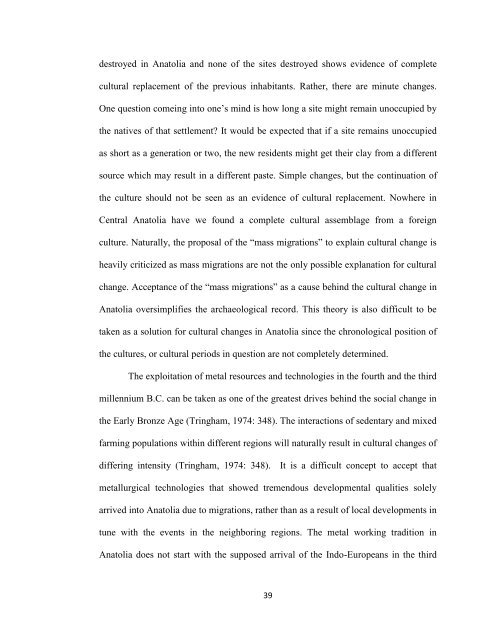EARLY BRONZE AGE DAGGERS IN CENTRAL ... - Bilkent University
EARLY BRONZE AGE DAGGERS IN CENTRAL ... - Bilkent University
EARLY BRONZE AGE DAGGERS IN CENTRAL ... - Bilkent University
Create successful ePaper yourself
Turn your PDF publications into a flip-book with our unique Google optimized e-Paper software.
destroyed in Anatolia and none of the sites destroyed shows evidence of complete<br />
cultural replacement of the previous inhabitants. Rather, there are minute changes.<br />
One question comeing into one’s mind is how long a site might remain unoccupied by<br />
the natives of that settlement? It would be expected that if a site remains unoccupied<br />
as short as a generation or two, the new residents might get their clay from a different<br />
source which may result in a different paste. Simple changes, but the continuation of<br />
the culture should not be seen as an evidence of cultural replacement. Nowhere in<br />
Central Anatolia have we found a complete cultural assemblage from a foreign<br />
culture. Naturally, the proposal of the “mass migrations” to explain cultural change is<br />
heavily criticized as mass migrations are not the only possible explanation for cultural<br />
change. Acceptance of the “mass migrations” as a cause behind the cultural change in<br />
Anatolia oversimplifies the archaeological record. This theory is also difficult to be<br />
taken as a solution for cultural changes in Anatolia since the chronological position of<br />
the cultures, or cultural periods in question are not completely determined.<br />
The exploitation of metal resources and technologies in the fourth and the third<br />
millennium B.C. can be taken as one of the greatest drives behind the social change in<br />
the Early Bronze Age (Tringham, 1974: 348). The interactions of sedentary and mixed<br />
farming populations within different regions will naturally result in cultural changes of<br />
differing intensity (Tringham, 1974: 348). It is a difficult concept to accept that<br />
metallurgical technologies that showed tremendous developmental qualities solely<br />
arrived into Anatolia due to migrations, rather than as a result of local developments in<br />
tune with the events in the neighboring regions. The metal working tradition in<br />
Anatolia does not start with the supposed arrival of the Indo-Europeans in the third<br />
39
















